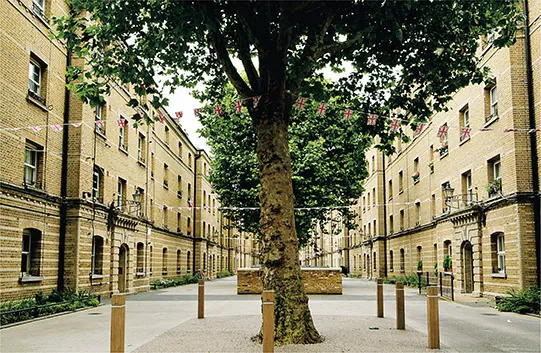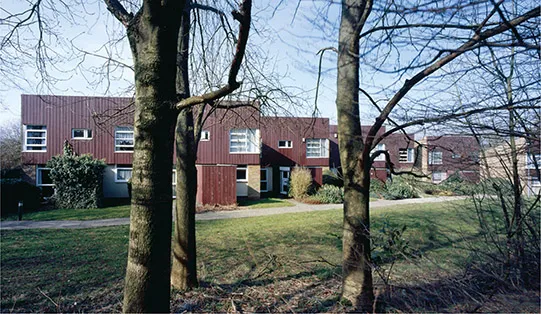Introduction
In the first edition of this book a ‘sense of place’ was defined as residents’ permanent sense of belonging to somewhere of value – this could be a neighbourhood or even a component of a neighbourhood that works and, most importantly, is esteemed by the people who live there. This sense of place is valued in the culture of European settlements – cities, towns or villages – and is a factor in their sustainability.
Not all cultures thrive on this kind of desire for continuity; much of the USA, Japan and now China do not. Houses in Japan achieve their highest value when they are new and lose value thereafter. In the UK the opposite is often the case, but only when the neighbourhood has achieved that elusive feeling of permanence, so highly valued and apparently embedded in the national psyche. Since World War 2 much perfectly serviceable housing has been consigned to the wrecker’s ball, not because of internal problems, but rather because the experience of getting from the nearest street to the front door was so poor.
How large or small does a new scheme have to be to create its own sense of place? What are the essential components or characteristics and what can (individual) new buildings contribute to an existing place, either to reinforce what is there already, or to provide the vital ingredient that cements a neighbourhood together for the first time?
Publicly funded new housing used to have an official design life (defined by a body called the Public Works Loan Board) of 60 years, and refurbished housing a design life of 30 years. However, it is unlikely that anyone ever imagined that at the eleventh hour of the twelfth month of the 59th or 29th year any of these schemes would suddenly become uninhabitable. Around 1965, after the local-authority building spree of the early post-war years, many social-housing programmes switched to the refurbishment of 19th-century terraced properties. On the basis of funding for a 30-year life, by 1995 they would have been due for demolition, but of course this has not happened. Some parts – roofs, windows, services and fragile internal components – have worn out and need replacing, hardly surprising as the structures themselves were already a century old when the investment to enable a further 30 years of use was made. And the reason these Victorian structures are even now worth far more than their intrinsic value in bricks and mortar is that they form part of the backdrop to a square or a street that has itself acquired a sense of place that is almost beyond price.
After half a century of use, many schemes developed exclusively as social housing from the 1950s through to the 1980s can now safely be judged a success or failure in placemaking terms. Other more recent mixed-tenure schemes can usefully be revisited although they have only been inhabited for a few years.
Claire Bennie brings her experience as a client in housing development to an exploration of the factors that make the difference between long-term success and failure. Architects try to build their reputations by demonstrating their most recent achievements in the knowledge that this will be what clients want to see. But in terms of creating a lasting sense of place there is so much more to be learned from close and often painful scrutiny of what has been subjected to the test of time.
1 The brick tenements at Peabody Avenue, Pimlico, 1885: a courtyard model repeated throughout London
2 Westfield, Ashstead, a Span estate designed by Eric Lyons, 1967: well cared-for, innovative housing set within a lush landscape – but with a high service charge
It may seem strange to start a book about housing design with an appeal to the commissioners of that housing, but their thoughtful patronage is crucial in allowing designers to realise any of what follows. About two-thirds of new housing is now generated by speculation, a short-term transactional process where notions of place, longevity and community are often sidelined in favour of a quick return on capital. The other third is the housing developed by long-term landowners – councils, housing associations, community groups and ‘great estates’ – whose motivations (and results) are more complicated. It is in the gift of commissioners and designers to ensure that their built output matures gracefully and has enduring popularity. Speculators need to care more about their legacy and landowners need to resist the overwhelming pressure to deliver at lowest cost and highest speed. Their architects must tirelessly advocate for layouts, materials and details that are both resilient and beautiful. The housing crisis needs sustained investment rather than frenzied bursts of quick fixes, which are likely to be demolished within our lifetimes.
Streets or estates designated ‘sought-after’ by estate agents are not necessarily the fanciest or the most attractive but they all have a sense of place, so they are cared for and loved by all who move in, and thus they endure. Commissioning homes for Peabody (a housing association founded in 1862) provided a close view of 150 years’ worth of housing development and its resilience. Six parameters – simplicity, security, shared space, stewardship, stability, and spirit – stand out as those that must be nurtured through commissioning, design and construction. They may make that lasting sense of place possible and they are explored in more detail below.
Sometimes it is easier to work out what makes a place last by considering what has failed and what we are reluctantly demolishing, while keeping in mind that the rationale for demolition is not always straightforward or transparent.
Simplicity In the 1870s, George Peabody’s trustees built the same simple yellow-brick tenement block in a courtyard format using the same contractor all over London. The buildings were decried as barracks-like, but later generations conferred conservation-area status on these simple and solid embodiments of health and comfort. They still stand today, with very little adjustment, their elegant sash windows only recently needing replacement. Regulations now often mean that simplicity is compromised. Architects and developers feel they have to design bespoke buildings for each site, where innovation is a higher priority than long-term success. Consequently, they never perfect buildability or detailing and residents can struggle to operate complex mechanical systems, resulting in overheated rooms or mouldy surfaces, both of which cause fabric failures and over time can lead to demolition. There is something to be said for designing the same building twenty times, getting it right through practice. Well-loved housing, whether on a budget or high-end, has only been achieved through inherent craftsmanship (once embedded in the construction industry but long since lost) or through careful selection of designers and constructors. The contemporary absence of the ‘art of construction’ may be the most damaging influence on the longevity of our housing stock.
Security Benjamin Franklin’s ‘Love thy neighbour, yet don’t pull down your hedge’ is especially pertinent in UK housing design where clear boundaries are particularly valued. The layout of housing, especially if it departs from the lower-density norm of streets and houses, is fundamental to engendering security and safety and thus to the lasting success of a neighbourhood. Many post-war estates are blighted beyond remedy by their high-level walkways, dead ground-floor garages and poorly overlooked spaces that allow anti-social behaviour to flourish. Essentials such as good lighting, natural surveillance and clarity of public and private space are now broadly accepted as axioms of good housing layout. Fences, front gardens and balconies provide a delicate balance between surveillance and privacy and the design of these thresholds is an under-rated craft.
Shared space The spaces we move through and share in housing developments – street, garden, community hall, café or corridor – shape the way we meet and relate to our neighbours. They have the potential to enhance those relationships or severely test them, depending on how well community members come together to take charge of their shared assets and evolve their use over time. The design of landscape is particularly important, especially in urban housing: every square metre of horizontal space is precious, with trees and plants essential for the wellbeing of the higher-density dweller. That amenity is under constant threat from our insatiable appetite for car ownership, although a driverless future may await us, provoking new spatial arrangements and possibilities. The enduring success of shared space is only partly in the hands of the designer of course; commercial space within a housing scheme has to be thoughtfully programmed by developers, and the use and management of spaces of all kinds requires a mature governance system within the community to serve diverse needs. The social foundations (including the empowerment of resident groups) that allow the evolution of community coherence, crucial to a lasting place, are beyond the scope of this book.
Stewardship Adequate and timely investment in maintenance ultimately underpins a housing scheme’s long-term success, no matter what the design. While designers can seldom control the level of this ongoing investment, it is imperative that they make it easier for the stewards and residents of their housing schemes to ensure that upkeep is affordable and easy to carry out. Fabric degradation occurs for a variety of reasons, including poor component choices, inaccessible services, flawed thermal performance, naive or over-complicated detailing and shoddy workmanship. Specification and detailing are now often left to constructors, but the risk of building failure is not managed this way. Lifts and door-entry systems exist at the less glamorous end of housing design, but their persistent failure costs landlords time and money and can ultimately lead to a failure of place. It behoves clients, designers and constructors to rediscover the craft of assembling good-quality components into robust buildings that can be managed within a sustainable budget. The success of schemes such as the Barbican and the Span developments comes at a high ongoing price, service-ch...


